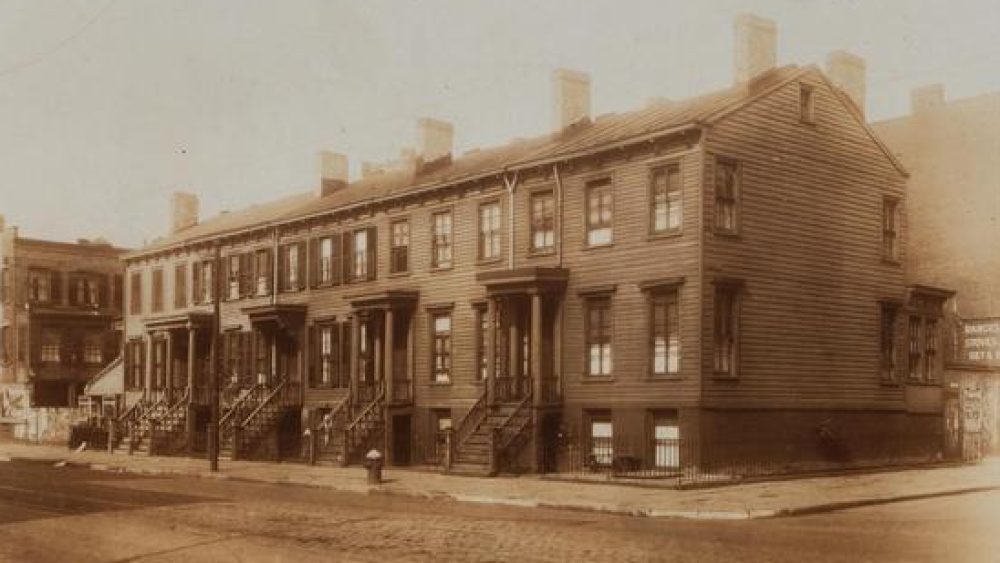A REMINDER OF THE VAST SPACES and great bargains still available in bucolic Delaware County, this mid-19th century farmhouse, currently owned by an artist and writer, was once the centerpiece of a farm called “The Overlook,” and it does indeed sit on a hill above the hamlet of Meridale, N.Y. The 6-bedroom, 2-bath house is just one of a complex of buildings, including a massive barn and a charming old storefront, not to mention nearly 30 acres of pastureland. Taxes not bad either — under $5,000/year.
I can’t say it better than Lynne Resch of Two Stones Realty, who has the listing right here, where you’ll also find more photos to dream on. See below for Lynne’s words:
Not unlike the nearby Hanford Mills Museum, this charming homestead is “intact”. This is how folks lived in the 19th century. A complex of buildings servicing their needs in a cozy, contained environment. Very much, if not exactly as it was when it was the engine of “The Overlook” Farm. And the property does indeed ‘overlook’ the charming hamlet of Meridale.Full disclosure… I am in love with the store… having passed it, and its enormous turn-of-the-century crock on the porch, hundreds of times on the way to Oneonta.The immediate live/work complex with big red barn would be satisfying enough. But the nearly 30 acres includes pastures and long-range views that put this offering at the top of the list. Spectacular views and open meadows hosted the owner’s own wedding and could provide the ideal for weddings to come.The location is perfect for work or play… for a Catskills entrepreneur to a NYC expat/escapee. Keep an eye on the store while rocking on the porch, toiling in the studio, negotiating that wedding party, or tending the flock and herd in the barns. The options satisfy a wide range of interests. Literally midway between two college towns… Delhi (15 mins) and Oneonta (15 mins) you will want for nothing. Mere walking distance to Greenane Farms’ bounty, their amazing CSA, The Dutch Deli for that quart of milk and the charming hamlet of Meridale’s Post Office.Area attractions nearby include The Hanford Museum, The West Kortright Centre, Stone & Thistle with Fable Dining, Harmony Hill, and the entire Western Catskills. 3 hours from NYC, easy access to Delhi and Oneonta, area attractions from The Hudson Valley to the Glimmerglass Opera, Fenimore Art Museum, and not-to-be-missed Farmer’s Museum in Cooperstown, make “Wedding Hill” a base for any dream.And yes, a Trailways bus stop, cell phone service, high-speed internet!… pinch me!









































 SO MUCH FOR PRECONCEIVED — or rather, outdated — notions. I hadn’t been to Jersey City in probably ten years, so when I went there yesterday (a distance of 7 whole miles from my home in Brooklyn) to visit a friend, my first reaction on driving through the streets was a surprised “This is NOT BAD!”
SO MUCH FOR PRECONCEIVED — or rather, outdated — notions. I hadn’t been to Jersey City in probably ten years, so when I went there yesterday (a distance of 7 whole miles from my home in Brooklyn) to visit a friend, my first reaction on driving through the streets was a surprised “This is NOT BAD!”

 For better or worse, depending on your P.O.V., Jersey City has gentrified, and it happened while I wasn’t paying attention. Walking around with my friend Joe (for as long as we could stand in the bitter cold), we passed a brick row house, right, with a nice Greek Revival doorway, colorfully painted, and a ‘For Sale’ sign. “It’s probably over a million,” Joe said. Said I, ever the victim of wishful thinking. “I’m guessing 899K.” Joe quickly found
For better or worse, depending on your P.O.V., Jersey City has gentrified, and it happened while I wasn’t paying attention. Walking around with my friend Joe (for as long as we could stand in the bitter cold), we passed a brick row house, right, with a nice Greek Revival doorway, colorfully painted, and a ‘For Sale’ sign. “It’s probably over a million,” Joe said. Said I, ever the victim of wishful thinking. “I’m guessing 899K.” Joe quickly found 





